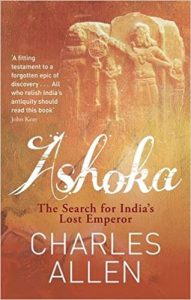Ashoka: The Search for India’s Lost Emperor
by Charles Allen
Little, Brown, London, 2012
pp. 480

SCHOLARLY AND READABLE
On Indian and, indeed, Asian, history and culture Emperor Ashoka (267-230 BCE) had an impact that can be compared to that of Constantine the Great (306-337 CE) on Europe and , indeed, the Middle East. Still, Constantine is the subject of stunning studies (Robin Lane Fox’s 1986 classic ‘Pagans and Christians’ comes to mind), while Ashoka has given rise to a much more modest corpus. Charles Allen sets himself a double task. He describes Ashoka’s person and life, and gives the story of his discovery. Allen succeeds admirably.
On the way he attacks religiously inspired intolerance, and the iconoclasm of the mostly British Orientalists by the followers of Edward Said. Allen’s irritation is understandable, but it is also his flaw. Academic distortions, even when they occur on the scale of the last few decennia, should be met with factual and methodological objections. One could, of course, argue that Allen does so implicitly by telling Ashoka’s story.
Before the 1830s Ashoka was completely unknown in India. Ashoka had set up Buddhism against Brahmanical practices and when a few centuries later Brahmins again got the upper hand in this religious and state competition, they succeeded in deleting Ashoka from living memory. Muslim invaders destroyed much of what was physically left of Buddhist knowledge, especially with the burning of Nalanda’s gigantic library in 1193-94, an obliteration which is the starting point of Allen’s argument.
From the 1830s up to the 1920s, gradually a picture arose of an emperor who subjected the greater part of South Asia , got remorse after a devastating campaign in Orissa (Odisha), became an ardent follower of Buddhism, and propagated his new found beliefs throughout his empire as witness large pillars and rock inscriptions. He also sent missionaries to other parts of Asia. Nehru was greatly inspired by Ashoka, and the emperor is now part of the pantheon of independent India. Ashoka’s lion capital is the symbol of the Indian Republic.
At the same time, ‘Ashoka’ is very much the story of ‘the rediscoverers of India’s lost history by a combination of archaeology and sheer dogged scholarship’. In Allen’s work they are rehabilitated, William Jones, James Hoare, Henry Colebrooke, Horace Hayman Wilson, James Prinsep, Markham Kittoe, Joseph Beglar, Ramakrishna Bhandarkar, Bhau Daji, Alexander Cunningham, up to Radha Kumud Mookerji. These scholars and amateurs pieced together disconnected information from rock edicts, Greek texts, Sri Lankan and Chinese sources, Sanskrit plays, sculptures and statues.
At a rather slow pace, Ashokan studies move on. In a last chapter Allen sums up where we are now. He even shows the one possible realistic likeness of Ashoka, ‘short and fat, with a balloon like head’. Charles Allen has pleased us with a scholarly and eminently readable book.
Published July 27, 2012
https://www.amazon.co.uk/gp/customer-reviews/R14FXKXOHCJYDB?ref=pf_ov_at_pdctrvw_srp
